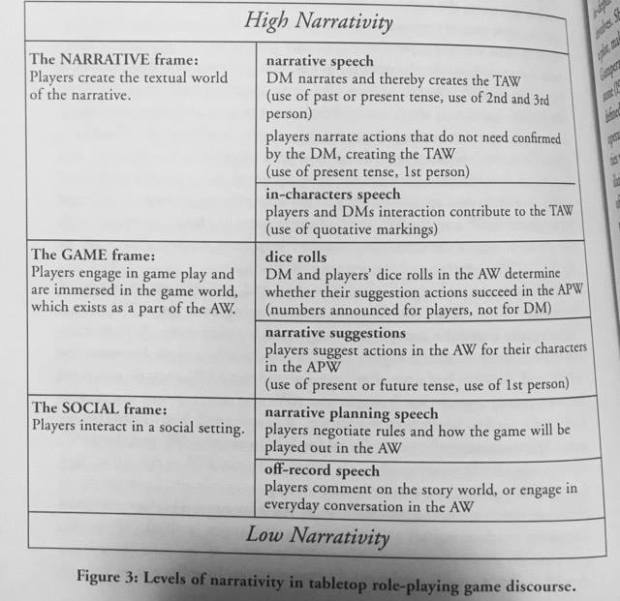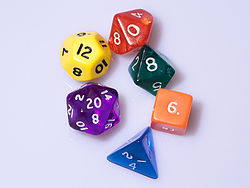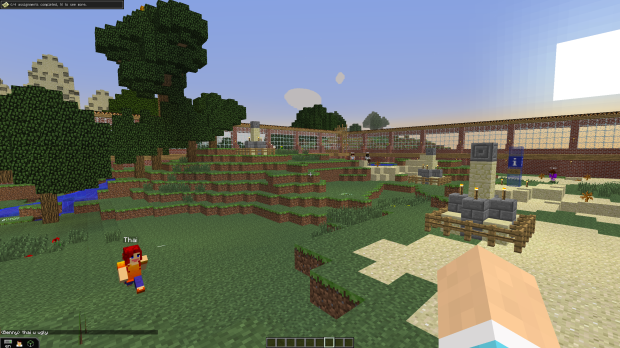Unit: Dungeons & Dragons
Focused Literary Studies 11
Lesson 1: Introduction to TRPGs and D&D
Learning Standard: By the end of this lesson, students will be able to define Tabletop Roleplaying Game, comment on its narrative function, and understand a basic history of the genre and D&D.
Competencies:
- Recognize an increasing range of text structures and how they contribute to meaning
- Recognize personal, social, and cultural contexts, as well as values and perspectives in texts, including race, culture, gender, sexual orientation, socio-economic status, place
- Recognize and appreciate how various forms, structures, and features of texts reflect a variety of purposes, audiences, and messages
Materials:
- PowerPoint slides with panels from 1984 comic Dark Dungeons by Jack Chick
- PowerPoint slides about TRPGs and D&D (history and genre)
- Netflix connection for Stranger Things clip (ep. 1, scene 2) -OR YouTube link (1:48 – 4:00): https://www.youtube.com/watch?v=CKtq-bZgS8I
- D&D manual
- D&D dice
- handouts: blank Venn Diagrams
- Adventure Time Season 1 (ep.18) DVD (link http://www.dailymotion.com/video/x3nhfyv)
___________________________________________________________________________
Structure:
20-25 minutes Anticipatory set: Stranger Things D&D video clip
-no context given first: who here has played D&D?
-what are the stereotypes of someone who plays D&D? Why?
-contrast with images from Dark Dungeons (anti-game propaganda): what are the
stereotypes here? how are they different?
25 minutes PowerPoint lecture & discussion
-history of TRPGs – elements of the genre
-history of D&D
20-25 minutes brainstorming Think-Pair-Share
-complete Venn Diagrams: “text” vs “TRPG”
-sharing: large Venn Diagram on the chalkboard to fill in
5 minutes wrap-up
-index cards: write a question you have about TRPGs/D&D and/or write something
D&D has in common with a “text”
If extra time: Adventure Time episode “Dungeon”
-as students watch, they write down things they notice that we discussed during think-pair-share (how does this episode bring together the TRPG & story genres? does it rely on any stereotypes we discussed?) — hand in their notes at end instead of index card
[next class: creating characters]
Unit: Dungeons & Dragons
Focused Literary Studies 11
Lesson 2: D&D Character Creation
Learning Standard: By the end of this lesson, students will have created their D&D character and reflected on why they made particular characterization choices
Competencies:
- Construct meaningful personal connections between self, text, and world
- Use writing and design processes to plan, develop, and create engaging and meaningful literary, imaginative, and informational texts for a variety of purposes and audiences
- Recognize personal, social, and cultural contexts, as well as values and perspectives in texts, including race, culture, gender, sexual orientation, socio-economic status, place
Materials:
- 2 printed character sheets per student (1 for draft and 1 for final)
- PowerPoint to scaffold character creation
- Character creation rules: http://dnd.wizards.com/products/tabletop/players-basic-rules
- Online character creator: http://www.orcpub.com
- handout with description of D&D character traits
- D&D dice
- Document camera (if available)
___________________________________________________________________________
Structure:
5 minutes review of last class
-key elements of D&D/TRPG
10 minutes PowerPoint/ modeling character creation
-explanation of process; rolling abilities on document cam (or showing groups of
students)
20 minutes choosing race, class, determining ability scores
-option to do this with dice or online
-groups of 2-3, sharing dice and helping each other (teacher circulates)
10 minutes presentation/ modeling character description (alignment, ideals, bonds, flaws,
background)
-one example of pre-written character — read aloud and explain the different aspects
-co-create a character on document camera as a class
30 minutes writing character description (alignment, ideals, bonds, flaws, background)
-individual writing exercise (on paper or devices)
-hand in characters & descriptions for review
5 minutes wrap-up
-option to share character name and something about him/her/it with the class
[next class: forming parties, choosing quests, looking at DM introduction]
Unit: Dungeons & Dragons
Focused Literary Studies 11
Lesson 3: D&D Gameplay Introduction
Learning Standard: By the end of this lesson, students will students will know their role in their D&D party, will have a basic understanding of the quest their party will be on, and will have started their D&D reflection journaling
Competencies:
- Recognize an increasing range of text structures and how they contribute to meaning
- Recognize personal, social, and cultural contexts, as well as values and perspectives in texts, including race, culture, gender, sexual orientation, socio-economic status, place
- Select and apply an appropriate spoken language format for an intended purpose
- Transform ideas and information to create original texts, using new or unfamiliar genres, forms, structures, and styles
Materials:
- D&D manuals
- D&D dice
- character sheets & descriptions (handed back from last class)
- paper and pens for D&D reflections (added to new D&D section of ongoing portfolio)
__________________________________________________________________________
Structure:
10 minutes review from last day
-hand back character sheets and descriptions (with formative feedback/questions)
10 minutes editing time
-chance to edit characters based on feedback (creating more well-rounded characters: what is your character’s background? what do they like doing? what makes them uncomfortable? etc.)
15 minutes explaining & modeling gameplay and dividing into parties, choosing DMs
-pre-arranged parties chosen by teacher
-DMs volunteer (if some students already have experience)
35 minutes beginning gameplay
-DM provides setting & beginning of quest
-groups of students begin their games; teacher circulates to help
10 minutes written reflection
-what do you think of D&D so far? What do you like or not like?
-what stands out about the DM’s opening dialogue?
-who are the members of your party? How does your character fit within your party?
[next class: gameplay immersion]
Explanation
This series of three lesson plans occurs at the beginning of a unit on Tabletop Role Playing Games (TRPGs) with the text Dungeons & Dragons (D&D) at its focus. The primary aims of the unit (as listed more specifically under the “competencies” headings in each lesson) are to guide students to rethink narrative structure from the inside of a story, to develop students’ inter- and intra-personal skills (learning to communicate in various modes and reflect upon their own identities), and to recognize the different contexts and perspectives of texts. To reach these objectives, students must become fully immersed within the game several times over the course of the unit. Bloom’s Taxonomy tells us that students must be able to know and understand something before developing the ability to analyze and evaluate it (Bloom, 1956); therefore, students must become comfortable with the conventions of Dungeons & Dragons before being expected to think critically about the game and their relationship to it. Because this genre will likely be unfamiliar to many students, I have supplemented the unit with plenty of scaffolding: we begin with an exploration of the history of the TRPG genre and D&D, using guiding questions to encourage students to think about D&D (and other TRPGs) as texts worthy of study. It is essential for students to realize the narrative potential of TRPGs prior to engaging in gameplay, at which point they will be asked to reflect upon their experiences. Without a solid foundation for understanding the game as a text, it would be a challenge for their later reflections to go beyond surface-level analysis.
One of the primary affordances of D&D and other TRPGs is that it engages students in the cognitive, affective, and psychomotor domains of learning. Getting students involved within the story grants them a chance to metacognitively analyze the narrative, and directly involving them in the plot development allows them to feel a personal connection to their characters and the events that befall them. Furthermore, actions like dice rolls and even acting like their characters encourage students to connect to the game on a physical level. Providing student with the above scaffolding will help them to realize the various ways they are becoming immersed in a text and reflect upon those experiences.
These lessons show the beginning of my gradual release of responsibility for this unit. In Lesson One, the teacher explicitly gets students to consider the purpose of the unit in general and shows them examples of narratives that use D&D as an embedded text (such as Stranger Things, Dark Dungeons, and Adventure Time); by showing students ways this game is included within written and televised narratives, the lesson introduces them to this new genre via a familiar one, providing a framework for understanding.
Lesson Two, on character creation, necessarily includes a great deal of teacher modeling: the teacher slowly walks the students through the process of creating a D&D character verbally while showing the physical process simultaneously. If the school has technology to support a digital projection of this process (such as a document camera), the teacher may use it in order to teach to the whole class at once; however, if this is not possible, the teacher may present to small groups of students and move more directly into guided practice, showing students through demonstration and allowing them to try their own creations with teacher input. For this lesson, the teacher must be intimately familiar with the process of creating a D&D character, as they must be able to model both the creation of character traits and the creation of a character description. In regards to the character description, the lesson includes modeling (i.e. showing students a pre-written description and explaining it), guided practice (i.e. creating a short description as a class, involving students in the process by using their input), and independent practice (i.e. getting students to create their own characters).
Lesson Three, on beginning gameplay, leads students into the world of D&D. Again, this process is modeled by the teacher (and, if there are experienced TRPGers in the class, these students may help model). The teacher should have pre-selected groups of students to form into parties with one Dungeon Master per party. Pre-selecting groups is especially helpful if some students have had previous experience playing D&D, as these students may provide student-led guided practice within the game. In later lessons, students will move further and further into independent practice, requiring less support as they become familiar with the conventions of gameplay. For lessons wherein students are primarily playing the game together (such as the latter half of Lesson Three), there should be time provided at the end of class for them to complete a reflection on their experience, providing guiding reflective questions and always moving their thinking up to a higher cognitive level.
This unit is easily adaptable to different learning exceptionalities, as it involves various ways of learning and representing knowledge. The reflections may be handwritten or typed, or even spoken into a tape recorder. Because only one participant per party (the DM) needs to read, the unit is user-friendly for those students who have reading difficulties. At the same time, the verbal interactions encouraged by gameplay should help to develop the communication skills of both native English speakers and English Language Learners. Using TRPGs (an expanded notion of text) as narrative in the English classroom levels the playing field for students, as it is unlikely that a large amount of students will be overly familiar with the genre; therefore, the majority of students should be comfortable with the gradual progression from teacher modeling to independent practice over the course of the unit.
References:
Bloom, B.S. (Ed.) (1956) Taxonomy of educational objectives: The classification of
educational goals: Handbook I, cognitive domain. New York ; Toronto: Longmans,
Green.


